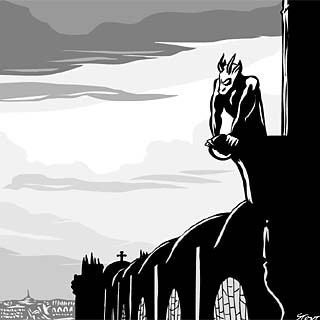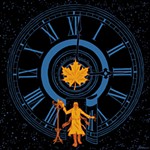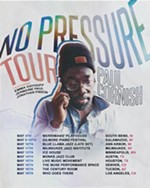Letters at 3AM
A Monster in Repose
By Michael Ventura, Fri., May 3, 2002

In my teens my Catholicism ripped in two. Emotionally, I very much wanted to be a priest ... to perform the sacrament of the Mass, administer the comfort of the confessional, and be part of this paradoxical institution, overwhelmingly male, that yet called itself the Bride of Christ. I kept these aspirations to myself because my intellect shamed my emotions: Church theology seemed not only mistaken but ridiculous. And as for priestly celibacy ... well, a Catholic bride is ideally a virgin, and the Church never claimed to be the Wife of God, so celibacy made a kind of sense ... but my body was at least as insistent as my intellect. The priesthood was out. And, though I was never abused by a priest or nun, people close to me were molested by both; I knew Church celibacy was a dangerous lie. As I studied the Church's gruesome history, and became aware of the terrible price millions still pay for its doctrine on contraception, I could no longer go to Mass even as a spectator. Yet I sometimes seek out an empty Catholic church to pray, like taking a solemn walk through the streets of childhood. All of which is to say: Now, with its crimes in plain view, I find myself looking at Holy Mother Church (as it's also called, virgin bride and mother, though unlike Mary this mother is also the bride of her own son? her people? the world? as always with Catholic theology, I'm befuddled) ... looking not only with anger but with grief, that such a splendid intention became such a destructive force in the lives of so many. And my thoughts turn to gargoyles ...
I tore out of a newspaper this week the photo of a gargoyle atop Notre Dame. Its body is thick and gives the impression of brutal strength, a strength that feels male -- yet two flaccid female breasts hang from its chest, nipples erect and pointing straight down to the city many stories below. The head, supported by a long powerful neck, is horned; the face is a disturbing meld of reptilian and canine, with an open mouth of pointed teeth to tear flesh. But what's most strange about this other-worldly predator is: Its stance is so relaxed -- almost slouched, its muscular, masculine arms lean on the stone railing, huge hands quietly folded one upon the other. The effect is of a monster in repose, hermaphrodite, leaning idly on the railing, daydreaming.
Clearly the beast is at home in the cathedral.
Construction of Notre Dame was begun in 1163. My reference books hedge on precisely when it was finished: "circa 1230." What's striking is that when Notre Dame was built, and for many centuries after, there was no way, no way at all, for anyone at street-level to take in this carefully sculpted, thoughtfully conceived monster. Even the priests and monks, their retinue and servants, for whom the cathedral was like a great ship that they manned upon the stormy sea of history -- even very few of them, surely, ever saw this particular creature. Probably only some workmen, over the centuries, knew its face -- though there are many other gargoyles (most more visible) on the walls and heights of Europe's classic cathedrals. Why was it necessary to include these monsters, even where they would not be seen? Why were they so carefully given a place as servants of the Church, the Bride, the Mother?
Remember: In the early centuries of the second millennium, when the great cathedrals were conceived and built, they were the apexes of their age -- technically, architecturally, artistically, religiously, philosophically, politically, they were the grandest, highest, most elaborate and beautiful creations that Western civilization had accomplished since the Romans a thousand years before. Some were fortresses as well as churches -- Mont-Saint-Michel (built 1203-28) repulsed every English attempt to capture it during the Hundred Years War. They were so important ... yet we don't know the names of the architects, builders, sculptors, nor most of the painters; we don't know the superb artists who created their legendary stained-glass windows (and we don't know how to make such glass today). We know little about how such primitive societies built such tall, complex, enduring structures. (We know more about the Vatican's Saint Peter's, but it was a late addition, not completed until the 17th century.) More than this, the need that built the cathedrals is foreign to us, impossible to imagine or duplicate -- the collective impulse that channeled so many resources, at the cost of so much toil, into buildings that not only expressed their visions of God but stood as three-dimensional maps of that vision. Peasants who could not read and did not understand Church Latin, knew their religion most directly from these edifices. Knew, quite literally, the face of God -- and of gargoyles. Whatever the theology may have been, when it came to creating houses of worship God and gargoyles were linked in the same vision, had their proper place in the same cathedral. But the builders left no record of precisely why.
The caption of the photograph I described says the creature "stands guard for the church." That is certainly one impression gargoyles give. (But isn't God strong enough to guard His church without them?) What is inescapable is that the monster is included in both the cathedral and the Church as an integral element. To worship in such a place means that you are surrounded not only by God, Christ Jesus, the Virgin, the saints, but also by what is hideous -- by voracious monsters whose mission is uncertain. Even if we accept them as guards, what exactly do they guard? Upon whom are these creatures to be loosed, and when, and why? They seem to have the run of the place. Their poses always imply action (and sound: many are screaming); their intense physicality, even in repose, quivers with the capacity for movement. So during Mass, during Confession, during anything that occurs in the cathedral, they are hissing, screeching, scrambling up and down the walls, hiding in the recesses, hovering upon the heights, even (as in the photograph) daydreaming in whatever way a hermaphrodite predator may daydream. And their activity is (architecturally, at any rate) integral to the purpose of the cathedral.
You find few such images in Protestant churches, if at all. Islam and Judaism forbid religious imagery entirely, as do many Protestant sects. In addition, gargoyles are tellingly rare in the churches and cathedrals of American Catholicism -- our pernicious, dishonest, reflexive American optimism denies the presence of monsters in the psyche, and anything monstrous is seen not as innately human but as an aberration. (This is the reason for our famous, oft-repeated "loss of innocence," an innocence so tenuous yet persistent that we lose it anew at every fresh catastrophe.) And perhaps this is at the core of why European Catholics don't share America's shock at the scandals of priests. In a cathedral like Notre Dame the architecture makes it quite explicit that Christ and the Virgin are not the only entities you'll encounter within. Demons, too, have the run of the place, they cannot be expunged merely by good intentions, and while they may serve as guards they certainly signify a warning: While you are enthralled in awe remember to be alert, for in the human psyche, as embodied by the cathedral, the monstrous is ever-present.
When we rhapsodize about the classic European cathedrals we speak mostly of their architecture and their marvelous stained glass. We tend to consider the gargoyles separately, parenthetically -- as though these monsters were merely, somehow, decorative. They are not. They are a part of religion, a part of humanity, even a part of God. You come to be redeemed, but it's possible you'll be devoured.
Oh it would be a great day if the Church as Bride of God tore off her fancy gowns, gave her riches to the poor, let go her pretensions to authority, and walked among her people as one of them (as Jesus did) ... it would be a great day if the mosques of Islam, the synagogues of Judaism, and the pretentiously virtuous churches of Protestantism forsook their doctrinaire edifices to be content with tents, as the ancient Hebrews were, eschewing every trapping, every purpose, but "to love the Lord Thy God with all thy heart, strength, mind, and soul" ... a day without monsters, an impossible day. For that, finally, is what the gargoyles signify, that is what their presence embodies. The cathedral builders were modest and honest. Modest, in that they did not affix their names to the greatest structures of their civilization. Honest, in what they admitted in their building: You cannot have religion without monsters.
Walk into a church, holding your child by the hand ... whatever the doctrine, monsters are crawling upon the walls. They are a part of God -- so warned the cathedral sculptors. You may not see them perched at the top of the cathedral, but they see you.








